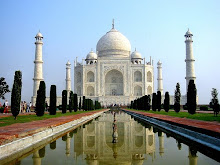Saturday, August 30, 2008
Kanchipuram
 Kanchipuram is known as one of India's Seven Sacred cities. Kanchipuram was the historical capital of the Pallavas. It was under the Pallavas from 6th to 8th century A.D and later became the citadel of Cholas, Vijayanagar Kings, the Muslim and the British. It has been a centre of Tamil learning, cultural and religious background for centuries.
Kanchipuram is known as one of India's Seven Sacred cities. Kanchipuram was the historical capital of the Pallavas. It was under the Pallavas from 6th to 8th century A.D and later became the citadel of Cholas, Vijayanagar Kings, the Muslim and the British. It has been a centre of Tamil learning, cultural and religious background for centuries.Kanchi is also known centre of the finest silk sarees made in the country. Kanchi has magnificent temples of unique architectural beauty bearing eloquent testimony to its glorious Dravidian heritage. Adi Sankara established his Episcopal seat (Kamakotipeetam). Kanchipuram is the birthplace of C.N. Annadurai, former Chief Minister of Tamil Nadu affectionately called as "Anna" by the people of Tamil Nadu. Kanchipuram, the Golden City of a thousand temples, is the capital of the Pallavas, the Cholas and the Rayas of Vijayanagar. During the 6th and 7th centuries, the Pallavas built some of the best temples in the city. The city was also a great seat of learning. Sri Sankaracharya, Appar, Siruthonder and the great Budddhist Bhikku lived, and worked here. Today, it is known not only for its temples, but also for its handwoven silk fabrics.
Kanchipuram or the Golden City of Temples is one of the most important centres of Hindu religion and also one of the most picturesque. The place is one of India's seven sacred cities and the second holiest after Varanasi. The city was once the capital of the Pallavas, Cholas, and the Vijayanagar rulers. It was under the Pallavas from 6th to 8th century AD but, during that period, was also briefly occupied by the Chalukyas, and the Rashtrakutas. Many of the temples situated here are the work of the Pallavas and later Cholas.
75-Km From Chennai, Tamil Nadu its called Religious Capital Of South India. Kanchipuram is one of the most sacred Hindu pilgrimage sites in India and the seat of the Shankaracharya. The temple city of Kanchipuram extends from latitude 12? 50' in the north to longitude 79? 45' in the east. The city is situated around 70 km from Chennai in the south Indian state of Tamil Nadu.
Kamakshi Amman Temple
India has three main cities where the Goddess Shakti is worshipped. Kanchipuram holds the most important rank among the three. In the same order, the three places are Kanchipuram, where the Goddess Kamakshi is worshipped, Madurai, where the Goddess Meenakshi is worshipped, and Kashi, where the deity is 'Visaalakshi'. The Kamakshi Amman temple is the hub of all religious activities in Kanchipuram. The temple is also in closer control of the Shankara Mutt, unlike the other temples, which are governed either by the Department of Archaeology, Government of India, or the Hindu Temples Department of the Tamil Nadu Government. The main tower over the sanctum (Vimanam) of the temple is gold plated. Also of significance is the Golden Chariot in this temple. The Golden Chariot is taken in a procession around the temple on Friday evenings around 7.00 p.m. This temple also features an Art Gallery with pictures depicting the history of Sri Adishankaracharya and the Shankara Mutt.
Kailashanathar Temple
Dedicated to Lord Shiva, Kailashanathar (also spelt as Kailashnatha) is one of the earliest temples built by the Pallava ruler Rajasimha Pallava and was completed by his son, Mahendra Varma Pallava in the 8th century AD. It is the oldest structure in Kanchipuram and the finest example of Pallava architecture in South India. The temple is situated among several low-roofed houses just over 1-km west of the town centre. Of all the temples in India, no other edifice has been so elaborately filled with all the 64 aspects of Lord Shiva. The temple is unique in its architecture and is viewed more as an architectural wonder than as a holy place. Hence, it is never crowded with locals. But, once in a year during Shivaratri festival large crowds visit the temple and there could be hours of waiting in long queues.
Ekambareshwar Temple
Ekambareshwar temple dedicated to Lord Shiva is one of the largest temples in Kanchipuram, spreading over an area of 12.14 hectares. This ancient temple is surrounded by a huge stonewall built in the early 16th century during the days of the Vijayanagar Empire. Ekambareshwar temple is of hoary antiquity, beginning as a small fane, it has grown over the centuries into a large one with innumerable shrines, Mandapams, Gopurams and Tanks. It is considered to be one of the most ancient temples in India and has been in existence even prior to 600 AD. It enshrines many traditions.
Subscribe to:
Posts (Atom)



